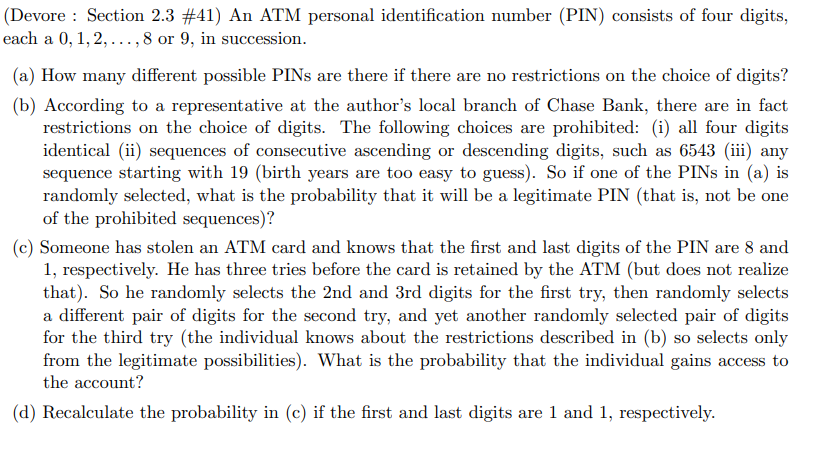Devore Section 2.3 #41) An ATM personal identification number (PIN) consists of four digits, ach a 0, 1, 2, ..., 8 or 9, in succession. (a) How many different possible PINs are there if there are no restrictions on the choice of digits? (b) According to a representative at the author's local branch of Chase Bank, there are in fact restrictions on the choice of digits. The following choices are prohibited: (i) all four digits identical (ii) sequences of consecutive ascending or descending digits, such as 6543 (iii) any sequence starting with 19 (birth years are too easy to guess). So if one of the PINs in (a) is randomly selected, what is the probability that it will be a legitimate PIN (that is, not be one of the prohibited sequences)? (c) Someone has stolen an ATM card and knows that the first and last digits of the PIN are 8 and 1, respectively. He has three tries before the card is retained by the ATM (but does not realize
Devore Section 2.3 #41) An ATM personal identification number (PIN) consists of four digits, ach a 0, 1, 2, ..., 8 or 9, in succession. (a) How many different possible PINs are there if there are no restrictions on the choice of digits? (b) According to a representative at the author's local branch of Chase Bank, there are in fact restrictions on the choice of digits. The following choices are prohibited: (i) all four digits identical (ii) sequences of consecutive ascending or descending digits, such as 6543 (iii) any sequence starting with 19 (birth years are too easy to guess). So if one of the PINs in (a) is randomly selected, what is the probability that it will be a legitimate PIN (that is, not be one of the prohibited sequences)? (c) Someone has stolen an ATM card and knows that the first and last digits of the PIN are 8 and 1, respectively. He has three tries before the card is retained by the ATM (but does not realize
Elementary Linear Algebra (MindTap Course List)
8th Edition
ISBN:9781305658004
Author:Ron Larson
Publisher:Ron Larson
Chapter2: Matrices
Section2.5: Markov Chain
Problem 36E: Customer Preference Two movie theatres that show several different movies each night compete for the...
Related questions
Question

Transcribed Image Text:(Devore: Section 2.3 #41) An ATM personal identification number (PIN) consists of four digits,
each a 0, 1, 2, ..., 8 or 9, in succession.
(a) How many different possible PINs are there if there are no restrictions on the choice of digits?
(b) According to a representative at the author's local branch of Chase Bank, there are in fact
restrictions on the choice of digits. The following choices are prohibited: (i) all four digits
identical (ii) sequences of consecutive ascending or descending digits, such as 6543 (iii) any
sequence starting with 19 (birth years are too easy to guess). So if one of the PINs in (a) is
randomly selected, what is the probability that it will be a legitimate PIN (that is, not be one
of the prohibited sequences)?
(c) Someone has stolen an ATM card and knows that the first and last digits of the PIN are 8 and
1, respectively. He has three tries before the card is retained by the ATM (but does not realize
that). So he randomly selects the 2nd and 3rd digits for the first try, then randomly selects
a different pair of digits for the second try, and yet another randomly selected pair of digits
for the third try (the individual knows about the restrictions described in (b) so selects only
from the legitimate possibilities). What is the probability that the individual gains access to
the account?
(d) Recalculate the probability in (c) if the first and last digits are 1 and 1, respectively.
Expert Solution
This question has been solved!
Explore an expertly crafted, step-by-step solution for a thorough understanding of key concepts.
This is a popular solution!
Trending now
This is a popular solution!
Step by step
Solved in 3 steps

Recommended textbooks for you

Elementary Linear Algebra (MindTap Course List)
Algebra
ISBN:
9781305658004
Author:
Ron Larson
Publisher:
Cengage Learning


Algebra and Trigonometry (MindTap Course List)
Algebra
ISBN:
9781305071742
Author:
James Stewart, Lothar Redlin, Saleem Watson
Publisher:
Cengage Learning

Elementary Linear Algebra (MindTap Course List)
Algebra
ISBN:
9781305658004
Author:
Ron Larson
Publisher:
Cengage Learning


Algebra and Trigonometry (MindTap Course List)
Algebra
ISBN:
9781305071742
Author:
James Stewart, Lothar Redlin, Saleem Watson
Publisher:
Cengage Learning